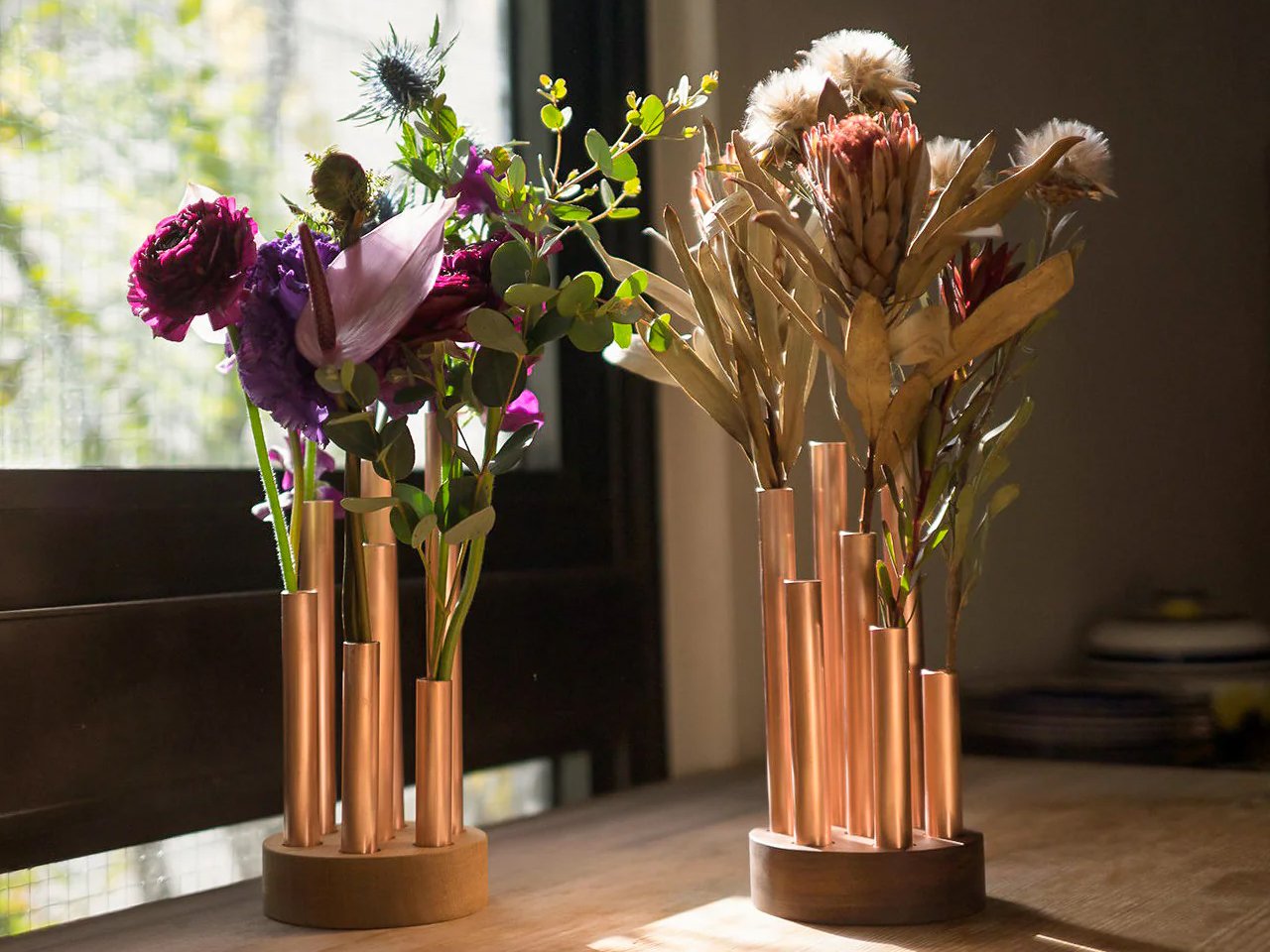Metallic finishes are taking centre stage in interior design, from the warm glow of brass and copper to the minimalist look of chrome. These reflective materials infuse any space with texture, depth, and a sense of understated luxury. When thoughtfully incorporated in different areas of the home, these metals introduce a dynamic play of light and dimension, enhancing the look of contemporary and classic interiors.
If you want to add glamour to any space, metallic accents in gold, silver, and copper can be incorporated into your home decor with these few simple tips:
1. Choose the Right Metal
Brass and copper add a warm, inviting feel, making them ideal for smaller spaces or as striking accents. In contrast, chrome delivers a sleek, modern look that can either take centre stage or provide a cool counterpoint to warmer tones. To incorporate metallic accents effectively, be clear about the style and mood you want to accomplish. This clarity will guide your choice of finishes and the scale of each piece.
Metallic finishes not only elevate the sophistication of a space but also enhance brightness and openness through their reflective nature, creating a more uplifting atmosphere.
Inspired by the Japanese art of ikebana, the Modular Flower Tubes offer a contemporary interpretation rooted in simplicity and elegance. At the heart of this piece are slender copper tubes of varying heights, which can be freely repositioned within a solid wooden base. The design encourages experimentation, allowing users to create ever-changing floral compositions that reflect personal style and seasonal shifts.
Click Here to Buy Now: $149.00
The standout feature is the copper finish, which evolves beautifully over time. As the metal ages, it develops a rich patina that adds depth, texture, and a sense of living history to the arrangement. This transformation honours the wabi-sabi philosophy, like appreciating beauty in imperfection and transience. The warm metallic tones contrast gently with the natural wood base, creating a harmonious balance of materiality. Together, they elevate floral display into a sculptural experience, blending traditional reverence for nature with modern, modular functionality.
2. Start with a Statement Metal
Choose a primary metal, such as a brass bed frame or centre table, and then complement it with one or two additional metals like chrome lamps to add depth and visual interest. Mixing metals intentionally adds elegance and depth to a space, while sticking to one finish can make it feel flat and one-dimensional.
Note that an excess of metal mixing can make a space feel cluttered. Therefore, it is best to stick to one or two metals in smaller rooms and no more than two to three in larger spaces. Make sure to select one dominant metal to carry the room, using the others as accents.
This brass vase concept reimagines the traditional purpose of flower vases, shifting focus from preservation to celebrating beauty at every stage of a plant’s life. Rather than simply holding flowers, it embraces the concept of aging gracefully, with the brass developing a unique patina over time. This natural process adds character and individuality to the piece, reflecting the beauty of imperfection and the retro aesthetic that is so prevalent today.
The vase’s form breaks from tradition, featuring a ribbon-like metal strip that curves into a knot, eliminating the need for a water-holding receptacle. Its minimalist design allows dried flowers to be showcased just as elegantly as fresh ones, prolonging their aesthetic value. By emphasizing the beauty in the natural process of aging, this vase encourages a shift away from the obsession with “new,” proving that even the passage of time can add to the beauty and significance of design.
3. Versatile and Functional Uses
Incorporate metals throughout the space in various ways, such as choosing lamps with brass bases, chandeliers with chrome details, or pendant lights with copper finishes. You can also update hardware like door knobs, cabinet handles, or drawer pulls with metallic finishes such as gold, silver, or copper.
Beyond accessories and accents, metals can be introduced through furniture by selecting pieces with metal accents, such as coffee tables, side tables, or decorative objects. Add brass or copper elements through light fixtures, faucets, and accessories, and use brass-framed mirrors to introduce warmth and texture.
This striking stool uses a single sheet of steel, bent to mimic soft fabric draped over wooden rods, creating a stunning visual illusion. At first glance, the flowing curves resemble suspended textile in linen or canvas frozen mid-air, yet the piece is entirely metal. This illusion is achieved through precision bending and minimal waste, showcasing metal’s versatility and the elegance of simplicity in modern design.
The brushed steel finish enhances the illusion, capturing light and shadow like real fabric folds while maintaining structural strength. Contrasting maple rods anchor the design, evoking ancient scrolls and adding warmth. One elevated edge functions as a handy side table, blending form with utility. This stool exemplifies how contemporary furniture can merge metal’s industrial edge with sculptural grace, offering tactile richness and visual intrigue in equal measure.
4. Balance Warm and Cool Tones
Metals play a key role in shaping the temperature and lighting of a room. Combining warm metals like brass or copper with cool tones like chrome or stainless steel creates a striking contrast, while pairing them with natural materials like wood or stone adds balance and harmony. For instance, the soft glow of brass is especially highlighted by candlelight, and introducing copper accents into chrome-dominated interiors adds a striking contrast in larger spaces.
In smaller spaces, metals not only serve as decorative elements but also reflect light, making the room appear brighter and more embellished.
Waxy Design Studio’s Pearl Chandelier reimagines elegance through a refined interplay of metal and light. Comprising 20 curved metal sconces arranged in a circular frame, each conceals a pearl-shaped bulb, evoking the image of oysters cradling precious gems. Available in black or white exteriors, the chandelier contrasts beautifully with its rich golden metal interiors and frame, creating a luxurious, jewel-like effect. The gold finish amplifies the light’s warmth, turning the fixture into a glowing statement piece that recalls a necklace suspended from the ceiling.
The metal finish plays a pivotal role in the chandelier’s visual impact. Its smooth, reflective surfaces capture and scatter light both upward and downward, adding dimension and atmosphere to any space. The combination of precision-cut metal sheets and warm metallic tones not only ensures structural elegance but also elevates the chandelier from functional lighting to sculptural art. It’s a sophisticated fusion of craftsmanship, material contrast, and ambient beauty.
5. Styling Metals by Design
Contrasting metals bring depth and visual interest to interiors, complementing a variety of design styles and colour schemes. Classic décor often includes gold, bronze, and brass in elements like lamps and mirror frames, while modern spaces favour the sleek appeal of chrome and stainless steel. Vintage styles mix brass and copper with wood to create a warm, rustic charm.
Incorporating metals into architectural details such as handrails, wall or ceiling panels, and skirting boards offers a subtle yet impactful way to introduce luxury and modernity. Blending these metallic elements with the interiors ensures a cohesive and well-balanced look while adding texture and sophistication to any space.
This sculptural chair stands out as a fusion of art and furniture design, instantly commanding attention with its bold, golden finish and raw, textured surface. More than a functional object, it serves as a visual statement, blending the rustic unpredictability of geological formations with the elegance of molten metal. Its irregular, chiseled form rejects traditional symmetry, evoking the look of a throne carved from natural elements. This dramatic aesthetic challenges conventional design, making the piece both avant-garde and timeless.
Crafted with meticulous attention to detail, the chair appears to be made from metal – possibly aluminium or a lightweight alloy – treated with a gold finish through leafing, metallic paint, or plating. The deep textures suggest hand-hammering or casting techniques, showcasing the craftsmanship behind its rugged elegance. Symbolically, the piece evokes power and presence, turning any space into a stage for bold expression. It’s a striking example of how furniture can transcend utility and become a powerful form of artistic narrative.
Using these approaches, interior designers have shifted from the uniform use of minimalistic chrome to blending metals for a more organic and luxurious feel. This method of layering of metals brings a sense of timeless comfort and elegance into the interior decor.
The post 5 Ways To Transform Your Home with Warm Metallics: The Interior Design Trend That’s Here to Stay first appeared on Yanko Design.

